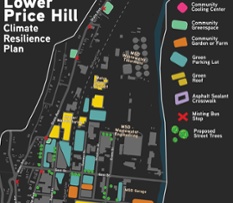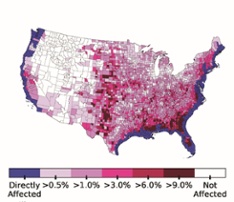Social Cohesion
Social cohesion is the ability for community members to cooperate to achieve shared well-being. Strong social cohesion is one of the most important factors in successfully responding to climate change impacts. Yet, climate change can threaten social cohesion. Affordable housing—a cornerstone of social cohesion—is especially vulnerable to the impacts of climate change. Ensuring the accessibility, stability, and security of affordable housing must be considered in resilient community planning. Reducing poverty and increasing economic mobility can ease the burden climate change places on social cohesion. For these reasons, the need to increase affordable housing underpins much of the socially resilient movement.
The United Nations Sustainable Development Goal 11 Sustainable Cities and Communities calls to make cities and human settlements inclusive, safe, resilient, and sustainable. Their targets include ensuring safe affordable housing, protecting community culture, and creating participatory, integrated, and sustainable urbanization and human settlement planning and management. The Intergovernmental Panel on Climate Change also emphasizes the importance of social cohesion in sustainable development in their Risk Management and Decision Making in Relation to Sustainable Development Report. Check out how Cincinnati is prioritizing social cohesion in their climate efforts:

Affordable Housing
Affordable housing is necessary to create a resilient city. As climate migration increases the number of residents in Cincinnati, there will be an increasing need for safe and sustainable affordable housing.
Cincinnati Financial Freedom Blueprint
Cincinnati City Planning and Engagement Connected Communities

Climate Safe Neighborhoods
Climate Safe Neighborhoods (CSN) is a national effort through Groundwork USA to identify neighborhoods that are more vulnerable to the effects of climate change because of racial and social injustices, engage frontline resident leaders and partners, and ignite action towards climate resilience.

Climate Migration
Extreme heat, more frequent large flood events, forest fires, hurricanes, and other natural disasters are displacing people from their communities. As a large city within this region, Cincinnati must develop and prepare the infrastructure and economy to be resilient to climate change—as well as prepare to receive those who might relocate to the City out of necessity.

Resilience Hubs
Resilience hubs are community facilities that can provide the necessary resources for communities to withstand climate challenges. Recreation Centers are places of community connection and present an opportunity for resilience hub development. Photo courtesy of Liz Dufour/Cincinnati Enquirer
Hamilton County Emergency Resources
Through The Hamilton County Emergency Management & Homeland Security Agency (EMHSA), disaster preparedness and public safety related emergency management activities are coordinated to serve and protect the public. Hamilton County EMHSA is concerned with all natural and manmade hazards including international and domestic acts of terrorism and homeland security functions.
The Hamilton County Multi-Hazard Mitigation Plan (MHMP or Plan) was developed to guide the County in a risk-based approach to become more resilient to the impacts of natural and technological hazards through mitigation planning. The Plan documents historical disasters, assesses probabilistic disasters through Hazus-MH and GIS analyses, and addresses specific strategies to mitigate the potential impacts of these disasters. Read the full plan here.
